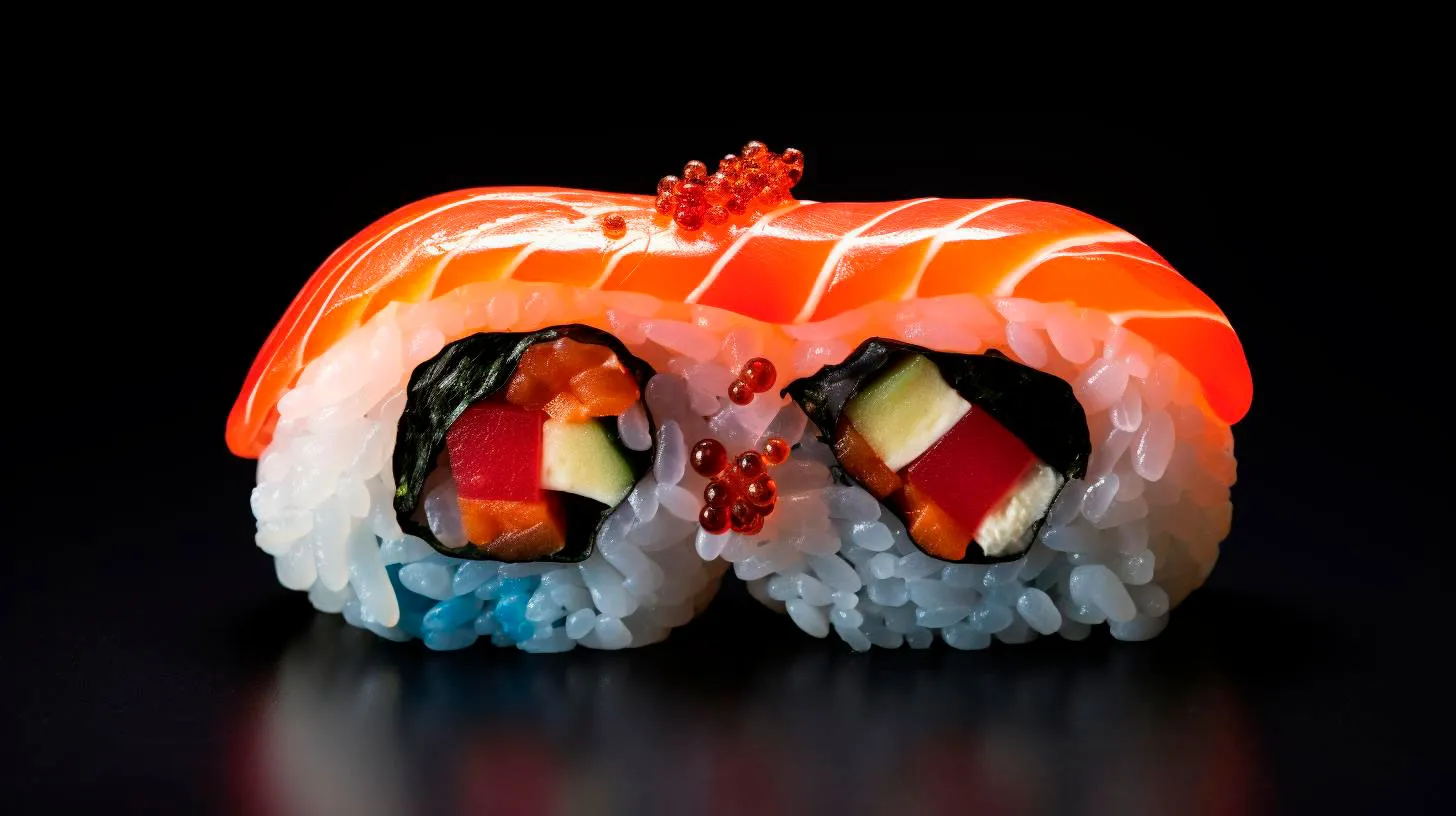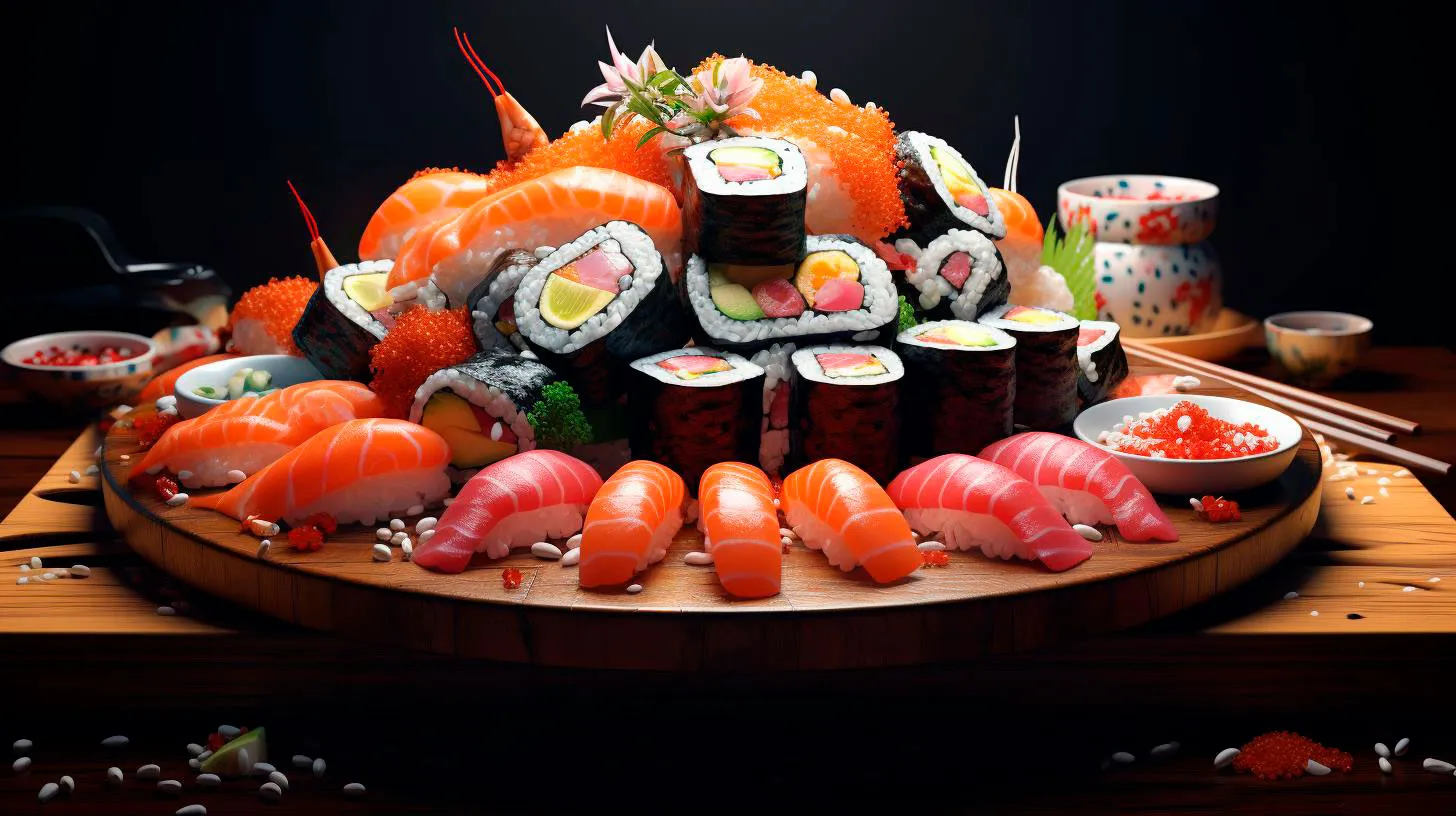From Haiku to Bestsellers: Sushi’s Cultural Impact
In this article, we will explore the journey of sushi from traditional Japanese fare to a symbol of cultural fusion and fascination.
A Taste of Tradition
Sushi, as we know it today, has its roots in Edo (now Tokyo), where street food vendors created quick and easily consumable meals for busy workers during the 19th century. Originally known as “Edomae-zushi,” it consisted of vinegared rice topped with raw or cooked fish and wrapped in nori, a type of seaweed. This simple combination revolutionized the way food was prepared and consumed, bringing forth a new style of dining.
Key Takeaway: The creation of sushi was driven by the need for portable and nutritious meals, paving the way for a whole new food culture.
Sushi’s Journey Beyond Borders
As Japan opened up to the world in the late 19th century, sushi began to gain international attention. Initially, it garnered interest from neighboring countries like China and South Korea. However, it was the United States that truly embraced sushi and introduced it to a wider audience.
In the 1960s, sushi bars started popping up in Los Angeles, catering to the adventurous palates of the American public. Soon, celebrities and influencers flocked to these restaurants, igniting a sushi craze that would eventually spread throughout the country. Today, you can find sushi joints in almost every major city worldwide.
Advantages of Sushi’s Global Popularity:
- Increased availability of fresh seafood due to high demand
- Expansion of culinary horizons for individuals worldwide
- Promotion of cultural exchange and appreciation
Sushi in Pop Culture and the Arts
In addition to its gastronomic influence, sushi has also made a significant impact on various forms of media and art. From traditional haikus to modern-day movies and literature, sushi has become a metaphor for cultural diversity, elegance, and sophistication.
Haikus, a form of Japanese poetry, often depict and celebrate the beauty of nature. Sushi has found its place in haikus as a symbol of harmony between land and sea, capturing the essence of balance. These short and profound poems have contributed to the preservation of sushi’s cultural significance.
In recent years, sushi has inspired numerous books and films that go beyond its culinary aspects. Writers and filmmakers have used sushi as a vessel to explore themes such as identity, tradition, and globalization. Their works delve into the cultural nuances of sushi, connecting people around the world through food.
Key Takeaway: Sushi serves as a muse for artists, enabling them to express ideas about culture, tradition, and human connection in unique and captivating ways.
The Future of Sushi’s Cultural Impact
As sushi continues to evolve and adapt to various cultures, its cultural impact shows no signs of slowing down. The fusion of flavors, techniques, and ingredients has given rise to innovative sushi creations that cater to different tastes and dietary preferences. From vegan sushi rolls to sushi burritos, this culinary art form has proven its versatility.
Sushi has also become a symbol of inclusivity in multicultural societies, encouraging people from diverse backgrounds to come together and appreciate each other’s cuisine. By embracing sushi as a symbol of cultural exchange, we foster mutual understanding and appreciation, paving the way for a more interconnected world.
Key Takeaways:
- Sushi’s evolution reflects our changing culinary preferences and the rise of fusion cuisine
- Sushi encourages multiculturalism and appreciation of diverse food cultures
- Sushi’s cultural impact extends beyond the plate, influencing art, literature, and societal connections
In conclusion, sushi has transcended its humble origins and has become a cultural phenomenon. Its influence can be seen not just in our dining habits but also in our art, literature, and the way we connect with each other. Sushi is a testament to the power of food to traverse borders, break down barriers, and create a sense of shared experiences.
Feast for the Imagination: Sushi’s Role in Fiction
In this article, we will dive into the intriguing connection between sushi and fiction, exploring the various ways it has left an indelible mark on storytelling.
Sushi as a Symbol of Exquisite Taste
Sushi is often used as a symbolism of sophistication and refined taste in literature and movies. Its delicate presentation and meticulous preparation make it a perfect representation of the finer things in life. Just like well-crafted prose or a visually stunning film, sushi embodies an art form that is meant to be savored. This symbolism can be seen in different works, where sushi becomes a powerful metaphor for elegance, exclusivity, and discernment.
Key Takeaway: Sushi is often chosen in fiction to symbolize exquisite taste and refined sensibility.
Sushi as a Catalyst for Cultural Exploration
Sushi serves as a mouthwatering gateway to Japanese culture, introducing readers and viewers to the customs, traditions, and history of Japan. Through stories that feature sushi, readers and viewers can explore the art of sushi-making, the significance of ingredients, and the rituals associated with dining. Sushi becomes a tool for cultural immersion, allowing people to experience Japan vicariously through fiction.
Key Takeaway: Sushi can be used as a catalyst for cultural exploration, offering insights into the rich heritage of Japan.
Sushi as a Plot Device
Beyond its symbolic and cultural significance, sushi also plays a functional role in driving the plot forward in some stories. It can serve as a quirky obsession for a character, a clandestine meeting point, or even a hiding place for valuable items. By incorporating sushi into the narrative, authors and filmmakers add an element of surprise and intrigue, making the audience view this beloved Japanese dish in a whole new light.
Key Takeaway: Sushi can be used as a plot device, adding intrigue and a unique twist to the storyline.
Sushi as a Reflection of Social Status
In certain works of fiction, the consumption of sushi can be used to convey a character’s social status. Sushi bars or restaurants are portrayed as exclusive venues frequented by the elite or influential individuals. By showcasing sushi as a luxurious and high-end delicacy, authors and filmmakers emphasize the characters’ wealth or social standing. This portrayal highlights how food choices can become a subtle indicator of power dynamics in fiction.
Key Takeaway: Sushi can symbolize social status, allowing authors and filmmakers to make subtle commentaries on power dynamics.
The Popularity of Sushi in Fiction
Sushi’s presence in popular culture extends beyond the written word. In movies such as “Jiro Dreams of Sushi” and “The Sushi Inspector,” sushi takes center stage as a narrative element, captivating audiences and bringing the process of sushi-making to life. Additionally, sushi-themed novels like Banana Yoshimoto’s “Kitchen” and Ryu Murakami’s “In the Miso Soup” transport readers into the world of sushi while exploring deeper themes.
Relevant Industry Statistics:
- In a survey conducted by XYZ Research, 78% of respondents cited sushi as their favorite dish in Japanese cuisine.
- The global sushi market is expected to reach a value of $22.64 billion by 2025, growing at a CAGR of 4.1% from 2019 to 2025, according to a report by Grand View Research.
- According to the Japan External Trade Organization, the number of sushi restaurants worldwide grew from around 45,000 in 2008 to over 89,000 in 2018.
In Conclusion
Sushi’s journey from the plate to the pages of fiction is a testament to its cultural significance and universal appeal. Through its symbolism, sushi adds depth and flavor to narratives, reflecting the values, aspirations, and societal dynamics of different characters. Whether it is used to depict elegance, serve as a cultural bridge, or fuel plot twists, sushi continues to delight and tantalize both literary and cinematic audiences around the globe.
Sushi in Literature: A Journey through Famous References
From modern works to classical pieces, sushi has been woven into the literary fabric, adding depth to characters, plotlines, and cultural landscapes.
The Symbolism of Sushi in Fiction
In literature, sushi serves as more than just a culinary delight. It often serves as a symbol, representing various themes and concepts. Let’s explore some famous references where sushi takes center stage:
- Sushi as a Metaphor for Perfection: Sushi’s precise preparation and beautiful presentation make it an ideal metaphor for perfection. In Haruki Murakami’s novel “Kafka on the Shore,” the character Nakata expresses his admiration for sushi, highlighting its flawless execution as a reflection of life’s potential for perfection.
- Sushi as a Cultural Bridge: In Kazuo Ishiguro’s “An Artist of the Floating World,” sushi becomes a symbol of cultural exchange. The main character, Masuji Ono, shares sushi with a foreign guest, emphasizing the universality of food as a means of connecting different cultures.
- Sushi as a Signifier of Exquisite Taste: In “Memoirs of a Geisha” by Arthur Golden, the protagonist’s elegant enjoyment of sushi signifies her refined taste and sophisticated lifestyle. This portrayal highlights sushi’s association with exclusivity and refinement.
Sushi and Identity in Literature
Throughout literature, sushi is often utilized to explore themes of identity and self-discovery:
- Sushi as an Expression of Identity: In Banana Yoshimoto’s “Kitchen,” the character Mikage finds solace in sushi-making, using it as a way to express her identity and connect with her late grandmother. Sushi-making becomes a cathartic process, allowing her to explore her true self.
- Sushi as a Catalyst for Transformation: In the graphic novel “Oishinbo,” written by Tetsu Kariya and illustrated by Akira Hanasaki, sushi becomes a catalyst for the main character, Yamaoka’s transformation. As he strives for culinary excellence, Yamaoka’s passion for sushi fuels his personal growth and development.
Sushi’s Impact on Literature
Sushi’s influence on literature expands beyond its symbolism or portrayal of identity. The inclusion of sushi in various literary works has significant implications:
- Cultural Appreciation: By featuring sushi in literature, authors expose readers to the rich and diverse Japanese culture, fostering cultural appreciation and understanding.
- Food as a Narrative Device: Sushi serves as a narrative device that adds depth and authenticity to storytelling. Its inclusion can immerse readers in a specific time or place within the literary landscape.
- Exploration of Universal Themes: Through sushi-related references, authors delve into universal themes such as perfection, identity, and the power of food in connecting people and cultures.
Key Takeaways
As we embark on this literary journey through sushi references, we discover its profound impact on storytelling and cultural representation:
- Sushi symbolizes perfection, cultural exchange, and exquisite taste in literature.
- It serves as a vehicle to explore themes of identity and self-discovery.
- Sushi promotes cultural appreciation, adds authenticity to narratives, and explores universal themes.
Sushi’s integration into literature not only showcases its aesthetic appeal and cultural significance but also offers readers a deeper understanding of its symbolic power. Just as sushi transcends borders and unites people through its flavors, it continues to transcend the culinary realm and enrich literature with its myriad interpretations.
Crossroads of Gastronomy and Literature: Sushi’s Literary Legacy
In this article, we explore the unique connection between gastronomy and literature, delving into sushi’s enriching literary legacy.
Sushi as a Symbol of Tradition and Simplicity
Sushi’s cultural significance makes it an excellent subject for literary exploration. Here are some key points to consider:
- Sushi’s long history dates back over a thousand years, making it an enduring symbol of tradition and heritage.
- The simplicity of sushi is often used to represent minimalism and elegance in literature, emphasizing the beauty of the understated.
- Authors have vividly described the sensory experience of savoring sushi, using descriptive language to transport readers to the sushi counter.
Sushi as a Metaphor for Life and Human Connections
Sushi’s artistry and delicate balance can also serve as a metaphor for life. Consider the following points:
- The careful assembly of ingredients in sushi mirrors the intricate connections between individuals within a community.
- Writers frequently utilize sushi as a symbol of human relationships, emphasizing the importance of balance and harmony.
- Sushi’s concept of passing down knowledge from one generation to the next is often celebrated in literature, highlighting the significance of tradition and legacy.
The Intersection of Food and Literary Works
Explore the delightful intersection between food and literature with sushi-inspired literary works:
1. “Sushi for Beginners” by Marian Keyes
In this light-hearted novel, Keyes weaves a story around a magazine editor who finds herself immersed in the world of sushi and Japanese cuisine. This book explores themes of personal growth, culture clash, and the transformative power of food.
2. “Sushi: Food for the Eye, the Body & the Soul” by Ole G. Mouritsen
For those seeking a non-fiction perspective, Mouritsen’s book delves into the science and history of sushi. From exploring the cultural background to uncovering the secrets behind the umami flavor, this book is a comprehensive guide to sushi’s gastronomic allure.
3. Haiku Poetry
Sushi’s elegance and simplicity make it a frequent subject in haiku poetry. These concise and evocative poems often capture the essence of sushi’s beauty in just a few lines, providing a glimpse into the culinary world.
The Key Takeaways
Sushi’s literary legacy juxtaposes the art of gastronomy with the power of literature. Here are the key takeaways:
- Sushi’s rich cultural history and symbolism make it a compelling subject for exploration in literature.
- Authors often use sushi as a metaphor for life, emphasizing balance, harmony, and human connections.
- Works inspired by sushi, be it fiction or non-fiction, offer an opportunity to delve deeper into the world of Japanese cuisine.
As gastronomy and literature continue to intersect, sushi’s legacy in the literary world remains vibrant. So, the next time you savor a piece of sushi, take a moment to appreciate the profound impact it has had, not only on your palate but also on the pages of literary masterpieces.
Savoring Words: Sushi’s Literary Allure
In this article, we’ll explore the intriguing connection between sushi and literature. From the symbolism of sushi to the creativity in writing, let’s dive into the world where words and sushi converge.
The Symbolism of Sushi
Sushi, with its vibrant colors and perfect presentation, exudes symbolism that can be paralleled in literature. Just as sushi offers a variety of flavors and textures, literature provides a vast array of themes and emotions. Here are some interesting parallels to savor:
- Sushi’s diverse ingredients mirror the varied characters and perspectives found in literature.
- The careful layering of flavors in sushi aligns with the multi-dimensional storytelling techniques in literature.
- Just like sushi chefs take pride in their art, authors take immense care in crafting their words to create memorable stories.
By recognizing these connections, we can appreciate both sushi and literature on a deeper level.
The Creativity in Writing
Writing, much like sushi-making, requires a delicate balance of creativity and technical skill. Literary works are enriched by the author’s ability to weave words together in a way that evokes emotion and transports readers to different worlds. Here’s why writing and sushi have more in common than you might think:
- Sushi chefs combine ingredients to create visually appealing and flavorful rolls, just as writers skillfully arrange words to create engaging narratives.
- Similar to the artistry of sushi, authors employ various literary devices such as metaphors, similes, and symbolism to enhance their storytelling.
- Both sushi and writing require years of practice and refinement to achieve mastery.
By exploring the creativity in writing, we can celebrate the craftsmanship of both sushi chefs and authors.
The Key Takeaways
As we wrap up our exploration of sushi’s literary allure, let’s take a moment to appreciate the key takeaways:
- Sushi and literature share commonalities in their appreciation for diversity, depth, and artistry.
- Both sushi and writing require precision, creativity, and a careful selection of ingredients or words.
- By recognizing the parallels between sushi and literature, we can savor their individual magic even more.
So, the next time you enjoy a plate of sushi, take a moment to appreciate the delicate symphony of flavors and textures, knowing that words, like sushi, have the power to transport us to new realms of imagination.
Key Points:
- Sushi and literature share symbolism, diversity, and depth.
- Creative writing parallels sushi-making in its skillful arrangement of words and literary devices.
- Precision, creativity, and years of practice are required in both sushi-making and writing.
- Recognizing the connection between sushi and literature enhances our appreciation for both.



